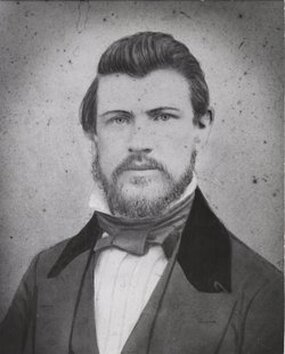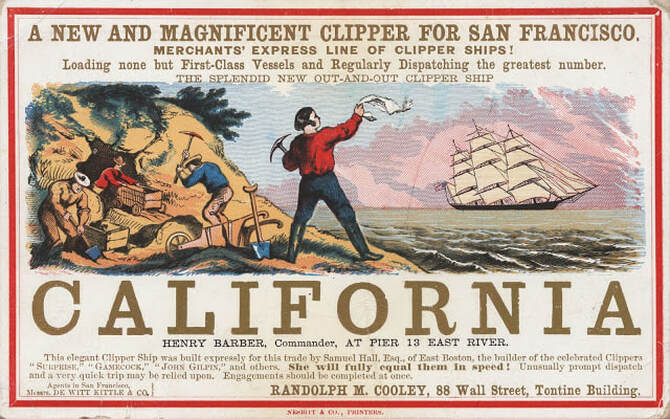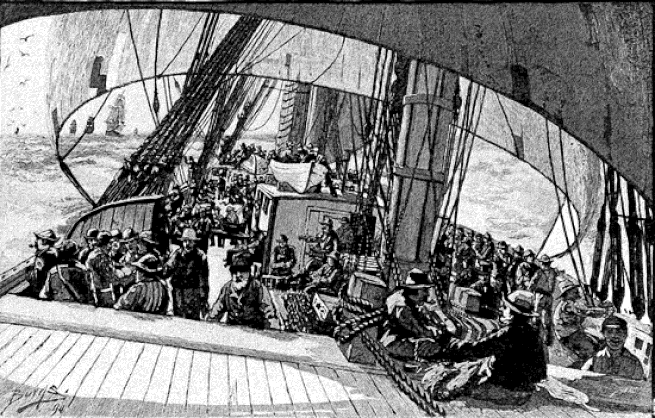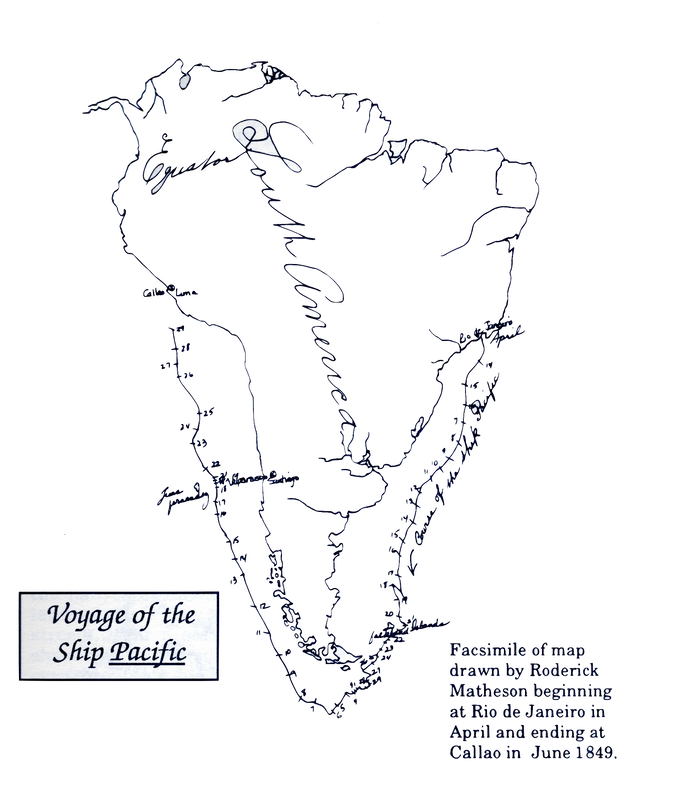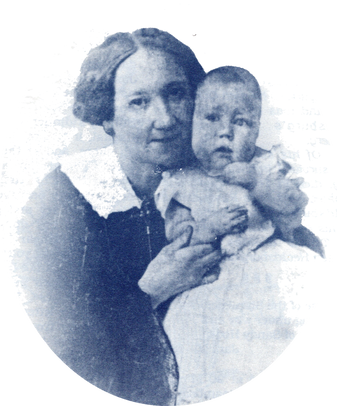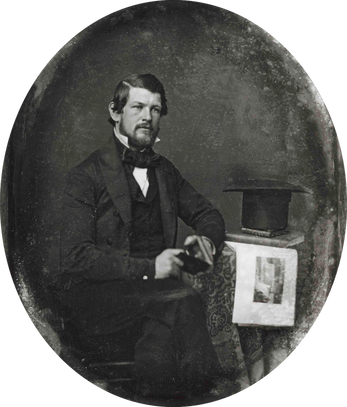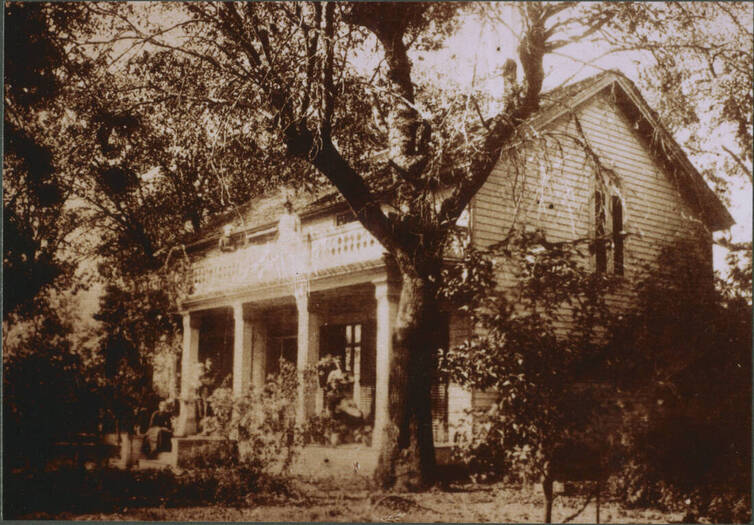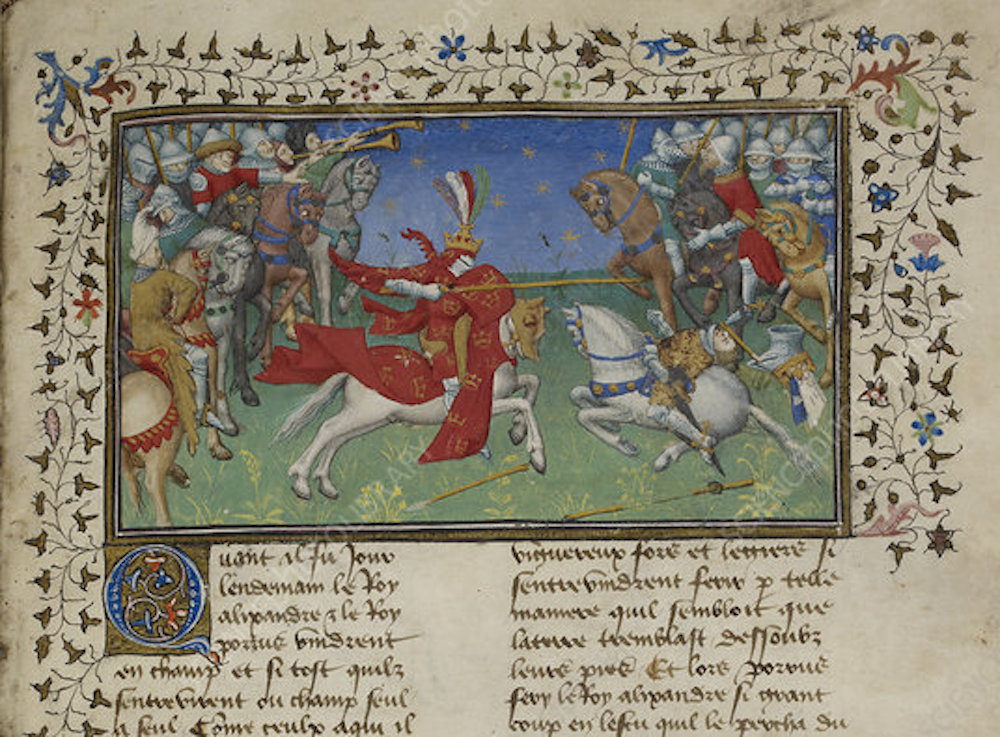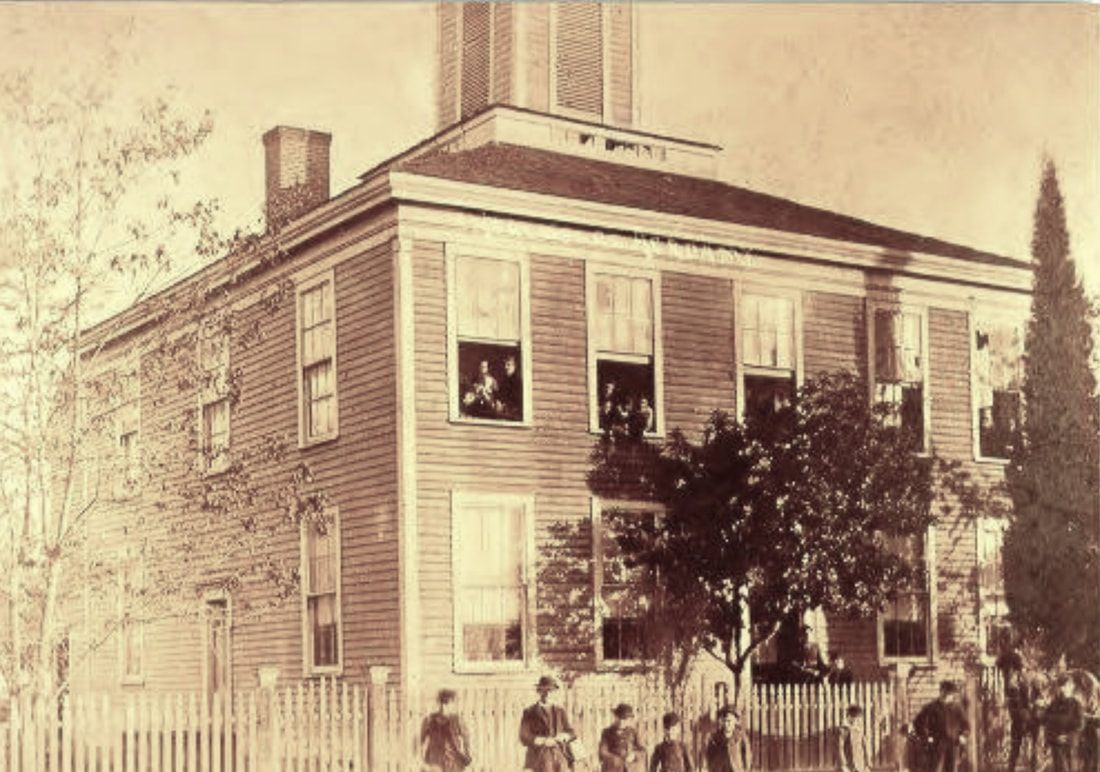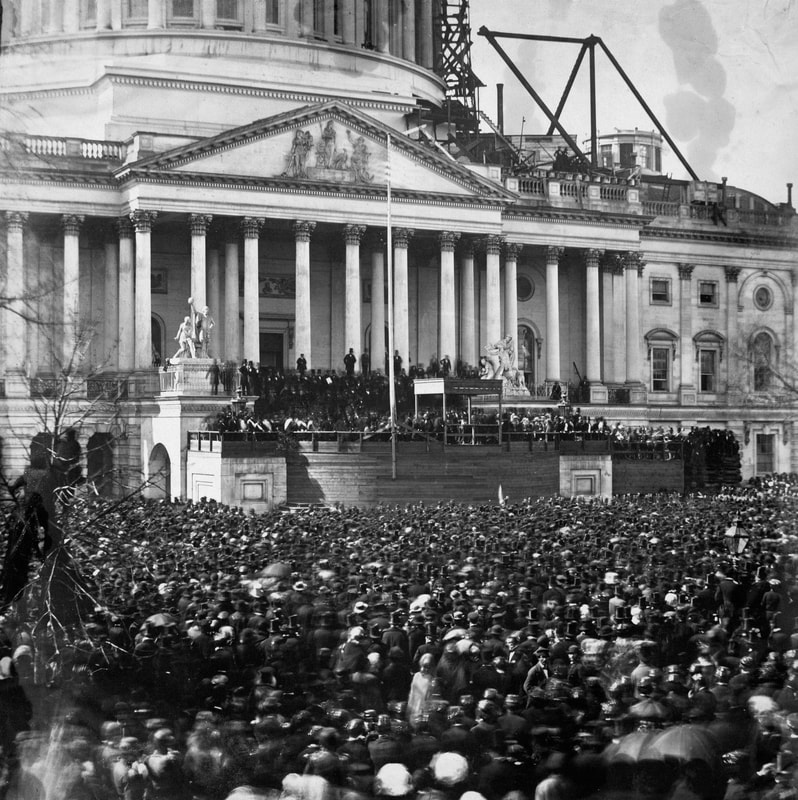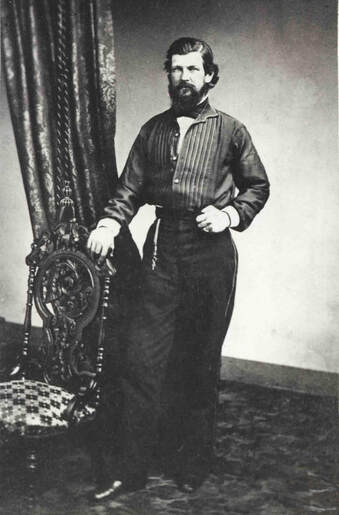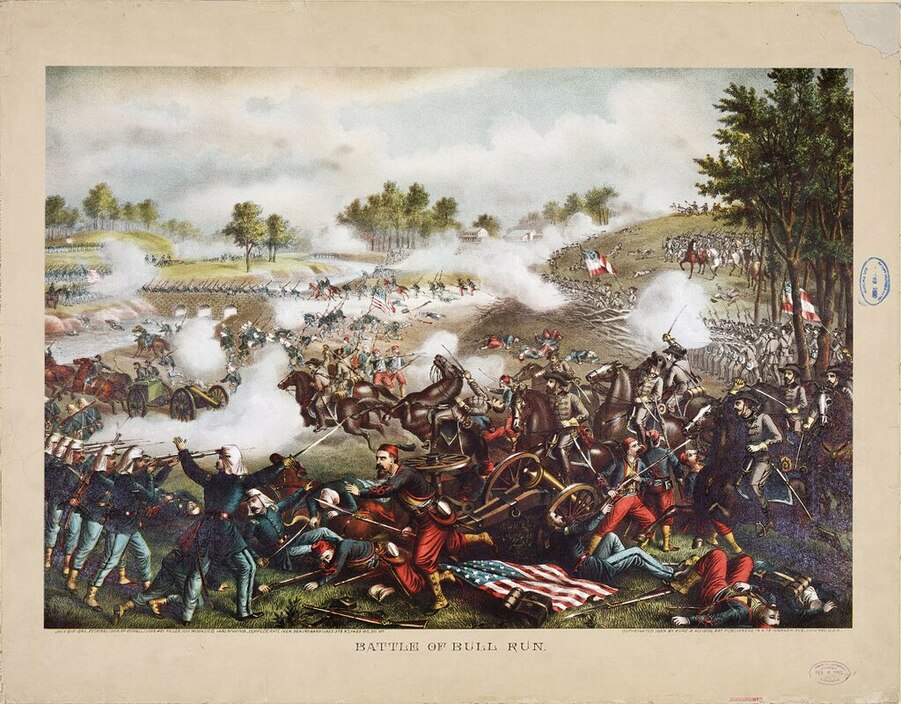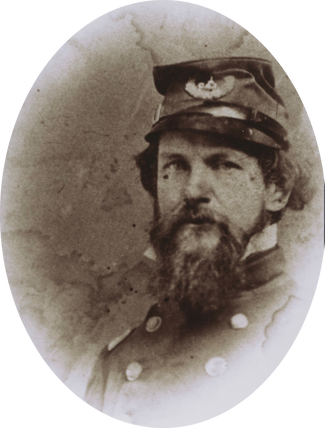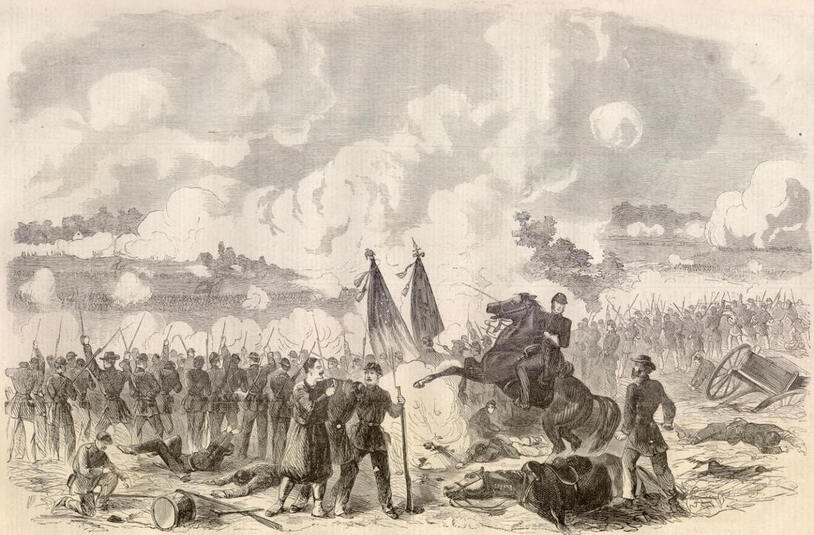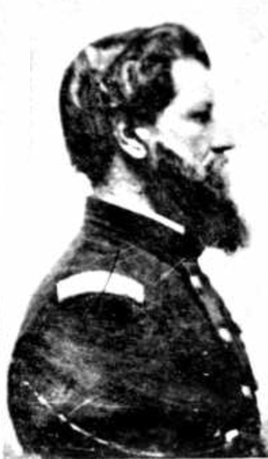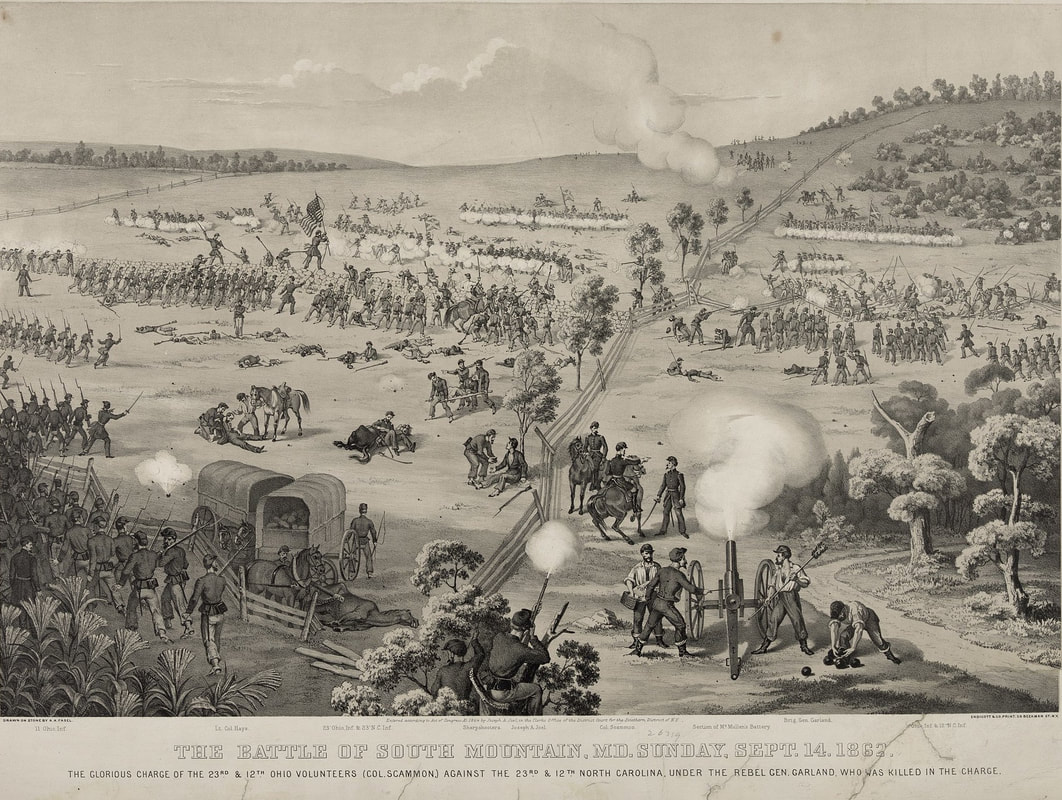Above: View of San Francisco taken from Telegraph Hill, April 1850, by Wm. B. McMurtrie, draughtsman of the U.S. Surveying Expedition. Man standing at left looking out at San Francisco Bay; sailing ships anchored in bay; goats on hill in foreground; Montgomery Street on the right; notes on lower margin, left to right: "Clarks Point"; "Rincon Point"; "Happy Valley"; "Long Wharf (building)"; "Pacific St. Wharf (building)"; "Apollo Warehouse"; "Niantic Warehouse"; "Sansome Street"; Portsmouth Square"; and "Montgomery St."(California State Library)
Col. Roderick Nicol Matheson
City Builder and Civil War Hero
© 2020 Hannah Clayborn All Rights Reserved
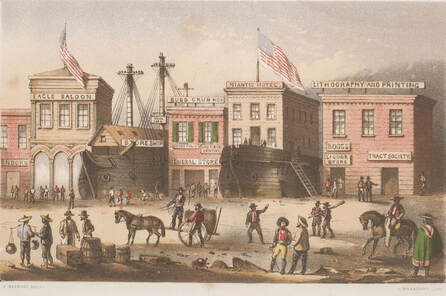 Hundreds of ships arrived in San Francisco during the Gold Rush, and many were abandoned as crews deserted to go to the gold fields. Some of the ships, like the whaling ship Niantic, were hauled ashore and incorporated into the city's earliest waterfront neighborhoods. The Niantic, shown here in a lithograph by wandering memoirist Frank Marryat, was pressed into service as a hotel near the corner of Clay and Sansome streets. The ship/hotel was destroyed during a fire that swept much of downtown in May 1851. Hundreds of ships arrived in San Francisco during the Gold Rush, and many were abandoned as crews deserted to go to the gold fields. Some of the ships, like the whaling ship Niantic, were hauled ashore and incorporated into the city's earliest waterfront neighborhoods. The Niantic, shown here in a lithograph by wandering memoirist Frank Marryat, was pressed into service as a hotel near the corner of Clay and Sansome streets. The ship/hotel was destroyed during a fire that swept much of downtown in May 1851.
The Portable City of San Francisco
Becalmed again and again as his ship approached the harbor at San Francisco, the frustration of the voyagers was released in long, loud bursts of huzzah on August 5, 1849, as the wind finally cleared the fog and revealed that legendary golden land.(8) When Matheson finally set foot in the raucous town it was undergoing its first round of civic mitosis. He seemed bewildered: It is a little ahead of anything that I have seen yet. It is built upon a hill of sand. I say built; I should say placed, for the tenements are mostly of canvas. A slight wooden frame with canvas stretched upon it. They charge $50 for the privilege of pitching a tent in the boundaries of the city. But we have selected a very pleasant little valley with high hills on one side and the harbour in front. Tomorrow we take possession of it. We have named it Excelsior Valley.(9) Roderick and his sailing companions were at first very anxious about the theft of their belongings, but soon relaxed. I never was in a place where I have seen so much property exposed in the open. The streets are lined with goods, the wharves or landings are in the same condition. My trunks have been out ever since I have been here...there is no more fear of anyone taking anything, for every person has more than he knows what to do with. If a man wants a clean shirt, he can buy one cheaper than he can get it washed. If anyone is caught stealing, he is either shot or has his ears cut off and whipped.(10) Less than a month later Matheson marveled, Only to think that a few months ago this was a wilderness and the place where now stands the portable city of San Francisco was occupied by a few mud huts. I can scarcely believe my own eyes that I am in the same place where I landed a few weeks ago. For the City has three-fourths of it been built since I came here or perhaps I ought to say, put up; for the present City was built in the United States and China and floated around the Horn or across the Pacific. [He refers here to pre-fabricated buildings.] Talk about Aladdin's wonderful lamp, and wonder ye who have never seen a California city rush into existence...(11) Matheson lasted only a short time at the mines; his real gold lay in the infant town of San Francisco, which he adopted wholeheartedly. His native talent soon brought him prominence, and he seemed to become involved in any project that furthered the interests of the city. The associations and friendships he made in this unique port in the 1850s would be lasting ones. Roderick Matheson asked his wife Netty to send him a picture of herself and the son he had never seen, Roderick Jr., who was born on July 27, 1849. He sent a daguerreotype of himself in return c. 1851. Netty and "Rody" would join him in San Francisco in 1852. One wintry Sunday evening, January 25, 1850, Matheson wrote home to his wife about his adopted city: Matheson was an active member of the fire department, which remained a completely volunteer organization until 1866. He helped organize the Vigilant Engine Company No. 9, in April 1852. They built a two-story brick building at 1219 Stockton Street between Broadway and Pacific, and by July had a first class, side-lever engine shipped out from New York. That was a busy summer, as he also ran against incumbent James W. Stillman for the office of City Comptroller, and was elected on November 2, 1852. He served for a year managing the finances and audits as a City Officer. He was a member of the Marion Rifles, a local militia, and in 1853 he is noted as a member of the executive committee of the Young Men’s Whig Club. During this time he lived in a house on Jackson Street, at the corner of Virginia Street.(12)
It seems Matheson could not stay away from teaching for long, and so he helped to organize the Mechanics' Institute in San Francisco, a training school, and became its president. Matheson's birthplace, Scotland, was the origin of these institutes in the 1820s, so he may have planted that seed in California. Later the Mechanics' Institute would evolve into the University of California, and the Institute kept a seat on the Board of Regents until 1974. After the easy surface (Placer) gold had been exhausted in 1853, San Francisco fell into recession with many unemployed, would-be miners crammed into its "portable" housing. The population had gone from 1,000 in 1848 to 34,766 by 1852. According to historian Taryn Edwards: On the evening of December 11, 1854, John Sime, Roderick Matheson, Benjamin Heywood, George Gluyas and a score of others assembled in the tax collector's office, at City Hall with the object of forming a Mechanics' Institute. They all shared similar dreams: boundless faith in the future of San Francisco as a port and industrial center, concern about the moral atmosphere of San Francisco, and most importantly they had an intense aversion of imported goods, which they believed kept prices high and deprived local people of jobs. Read More about the Mechanics' Institute Politics attracted Matheson like honey draws a bee. In 1854 he was appointed a General of Division of the Mexican Army, and resident Commander of Mexico in San Francisco, after spending time in Mexico working on the Gasden Purchase. As Commander he contributed greatly to better relations between the United States and Mexico. His Mexican Commission was confirmed by Juarez, then Chief Justice of Mexico, and was still in effect at the time of his death.(13) Rod Matheson's San Francisco
|
|
Epilogue
It is unknown if or how much the Matheson family received in private charitable donations to forestall foreclosure of their 300-acre farm. At the 14th Session of the California State Assembly in January 1863, it proposed to appoint Col. Matheson’s 68 year-old father, Thomas, to the position of House fireman, with the pay of $5.00 a day. Thomas and Jane had come to live with Roderick and Netty in Healdsburg sometime in the late 1850s, but it is not known how long they remained. That proposal was later shelved in favor of new relief resolution 479, that went on file in April 1863. Thomas served as a Porter for the Journal Clerks' room of the California State Assembly in April 1863.(33) The Assembly made a proclamation in January, 1863, which included the following: …we have been pained to hear of the.death of the gallant Colonel Roderick Matheson, one of the first to unsheathe his sword in defence of the cause in which all our hearts best sympathies are enlisted, and who from his first brilliant action on the j bloody field of Manassas to the day when he fell heading the forlorn hope in the battle of South Mountain, ever made that sword a rallying point for his country’s defenders and a flaming brand of destruction to her foes. Resolved, That in the death of Colonel Matheson California has lost one of her noblest sons, whose name will long he remembered as a synonym for all those gallant qualities which insure to their possessor everlasting fame.(34) In April 1863 the California State Assembly passed Resolution 479, an act for the relief of the Matheson Family. The discussions were as follows. …Mr. McNabb thought this an appropriate time to move to take up Assembly Bill No. 479— An Act for the relief of the family of the late Colonel Roderick Matheson [$5,000] On motion, it was taken up. Mr. Crane opposed the bill as bad in precedent. Mr. Nixon advocated it on patriotic grounds. Mr. McNacb said the estate of the deceased was worth $6,000, and mortgaged to the amount of $4,800. The widow was getting thirty dollars a month from the Government, which was inadequate for the education of the children. When the war broke out Colonel Matheson immediately mortgaged his property for something near $4,000, and about $3,000 of it was spent in raising and equipping the First California Regiment — of which every Californian has reason to be proud. The bill was read a third time and passed.(35) By 1865 Colonel Matheson’s old friends had not forgotten him. W.C. Ralston was in charge of a committee in San Francisco to pay for and erect a monument over his grave at Oak Mound Cemetery.(36) In December 1865 the California State Assembly took up a proposal to offer Col. Matheson’s 16 year old son, Rody, a position as their Assistant Paper Folder. The proposal was voted down, however, 21 to 36. Those who voted against stated that they preferred direct aid. When his supporters tried to appoint him a page, Rody himself deferred to another young man who needed the money for his education.(37) Roderick Matheson, Jr. (Rody), the son that Colonel Matheson so wanted to attend West Point, never made it to that academy, and it might have changed his life if he had received that job as an Assistant Paper Folder or Page. Continuing to labor in agriculture, he died after a terrible threshing machine accident at Davisville near Sacramento on July 27, 1870, about five years later. As his father’s death was charged to neglect at the army field hospital, Rody’s death was also blamed on lack of medical attention. He left a young widow, but no children.(38) Col. Matheson’s wife Netty, as previously mentioned, was awarded a widow's pension and lived the rest of her life on the Healdsburg farm, which was saved from foreclosure by resolution of the State Assembly. By 1880 she was living with her children Nina (Maria Antoinette) and George, and her brother and sister, Jesse and Emma Seaman. One source says Jesse was her cousin. Netty died in Healdsburg on February 28, 1887. George, Roderick Matheson’s youngest son, born just before he left for Washington D.C., was only 26 when he died November 9, 1887, from injuries sustained when his carriage overturned on his way home.(39) Netty, who died earlier that year, was spared the sorrow of seeing the life of a third young Matheson snuffed out. Marie Antoinette (1855–1920), always known as Nina, Roderick Matheson's only surviving daughter, lived in Healdsburg all her life, marrying a prominent local rancher's son, Jirah P. Luce, Jr. (1843–1921) in 1886. They had two children Nina Luce Rose (1888–1986) who married Guy Rose; and Jirah E. Luce (1890–1977), who married Margaret Z. Grove in 1926. Roderick Matheson's granddaughter, Nina Luce Rose, lived in Healdsburg all of her life, and his great-granddaughter, Nina M. Von Tillow (1916–1994), lived in Healdsburg until just before her death. Maria Antoinette Seaman Matheson’s brother (or possibly cousin) Jesse Seaman, who accompanied her when she came to California in 1852, lived a long life in Healdsburg. Born in 1831, he helped Roderick Matheson in San Francisco in the Comptroller’s office, accompanied him to Mexico in the 1850s, and purchased land and farmed with him in Healdsburg. He died at age 85 on February 19, 1916. Roderick Nicol Matheson had only one sibling, an older sister, Elspet Cathrine Matheson, born May 5, 1821, in Killearnan, Ross and Cromarty, Scotland. By 1860 she was living in Portland, Oregon, and married to William Patterson, a painter by trade, born in Scotland in 1812. They may have been peripatetic, or a blended family. Three of their children carried Matheson family names (Jane 15, Elspet 11, and Ellen 7) and were born in New York. Two others, William T. 17, and Mary 13, were born in Louisiana and Georgia respectively. Young William T. Patterson apparently got counted twice that year, because he also appears in the Matheson household in Healdsburg in 1860. By 1880 William and Elspet Patterson were living with their daughter Elspet, and show no occupation. The younger Elspet was then married to an accountant named Georg H. Andrews. William Patterson died by 1886, when Elspet Matheson Patterson appears as a widow boarding in various Portland locations until I lose track of her in 1906.(40) Col. Roderick Matheson’s Civil War sword and a painting of the First Battle of Bull Run were passed down to Jirah E. Luce, who donated these and other items to the Healdsburg Museum. Other family members also donated artifacts and documents including lovely, tiny dresses worn by Netty in the 1850s and 60s, with bell sleeves and voluminous hoop skirts. Matheson’s invaluable letters were also donated to the Healdsburg Museum.(41) The Matheson home at 751 South Fitch Mountain Road, an extension of Matheson Street, was enlarged and remodeled by Nina Matheson Luce and her husband Jirah in 1904. It went through another transformation when it was purchased by bank president George Warfield and his designer wife, Genevieve, in 1920. The home has been restored since that time, but has essentially retained its 1920 exterior. ENDNOTES
1. Most information in this article can be found in the sources listed in the first section below. Some of the older sources, including my own works, contain errors in dates and other details, as often occurs when errors are copied. The second section contains additional or new sources. Samuel Cassiday, An Illustrated History of Sonoma County, California, Lewis Publishing Co: Chicago, 1889. (This source contains an incorrect birth, marriage and other incorrect dates), 346-347. Frances D. Davis, Colonel Roderick Matheson: A True American, unpublished report, 1969 (Healdsburg Museum Archives). Hannah Clayborn, "Colonel Roderick N. Matheson: Civil War Hero from Healdsburg", in Russian River Recorder, July/Aug. 1981, Issue 21, 5-8. Charles M. Otstot, "Roderick Matheson: California Pioneer and Civil War Hero", manuscript copy, (Healdsburg Museum Archives). Charles Mathieson Otstot, "The Civil War Letters of Colonel Roderick N. Matheson, March 1861 - August 1862", unpublished manuscript (Healdsburg Museum Archives). An edited version of Colonel Matheson's letters from 1849 to 1853 appeared in the Russian River Recorder, Issues, 35-38, 40, Spring, 1989 through Summer 1991. Maria Antoinette Seaman, born about 1830, was the daughter of Obadiah Seaman (1788-1865) and Mary Fowler Seaman, a pre-Revolution Quaker family from the Putnam Valley of Putnam County, New York. Maria Antoinette Seaman in the New York City, Compiled Marriage Index, 1600s-1800; Marriage ID: 2220313701, The New York Genealogical and Biographical Record (quarterly), 1932. on microfilm at Family History Library, Salt Lake City, Utah. https://www.wikitree.com/wiki/Seaman-1444#_note-0. Research by relative Craig Wilson: https://www.wikitree.com/wiki/Matheson-1433 Thomas Matheson: Redcastle was sold by Sir William Fettes to Sir William Baillie in 1838 who had William Burn remodel it in 1840 - the year the family immigrated to New York: https://www.wikitree.com/wiki/Matheson-1434 Obadiah Seaman (60 years); Census Place: Putnam Valley, Putnam, New York; Roll: 581; Page: 45A. Thomas Matheson: ancestry.com, Thompson Family Tree. 2. An Illustrated History of Sonoma County, California, Lewis Publishing Co: Chicago, 1889. pp. 346-347. 3. The census records spell the family name Mattison, and give Maria A.’s age erroneously as 64 (she would be about 19 or 20). But it does record her 10 month-old son as "Roger." Year: 1850; Census Place: New York Ward 8, New York, New York; Roll: 542; Page: 329A. 4. Matheson Letter 26 Feb. 1849. 5. Matheson Letter 22 Jan. 1849. 6. Matheson Letter 28 Feb. 1849. 7. Matheson Letters 11 Nov. 1849 . 8. Matheson Letter 4 Aug. 1849. Date of arrival at San Francisco: https://www.maritimeheritage.org/passengers/pc080549.html 9. Matheson Letter 5 Aug. 1849. There is an Excelsior District in San Francisco, that has an official mapping date of 1869. However, this could be all or part of the area of the southern part of San Francisco (not to be confused with South San Francisco) that was Matheson’s first campsite. 10. Ibid. 11. Matheson Letter 17 Sept. 1849. 12. Our San Francisco Correspondence, Sacramento Daily Union, Volume 5, Number 648, 21 April 1853. Vigilance Company No. 9 at: https://www.guardiansofthecity.org/sffd/history/index.html. San Francisco City Directory 1852-53, Parker, James M: Matheson R. city comptroller, h Jackson, cor Virginia; also listed under City Officers, pp. 108; 162. Matheson as City Comptroller: runs for election against James W. Stillman, Daily Alta California, Volume 3, Number 303, 2 November 1852.is elected: Daily Alta California, Volume 3, Number 286, 16 October 1852. Daily Alta California, Volume 3, Number 300, 30 October 1852. 13. Samuel Cassiday, An Illustrated History of Sonoma County, The Lewis Publishing Company, 1889, pp. 346, 347. Demographics of San Francisco, 14. An Illustrated History of Sonoma County, California, The Lewis Publishing Company 1889. 1850 Census Records, San Francisco. Obituary of Jesse Seaman, Healdsburg Tribune, Enterprise and Scimitar, Volume XXVIII, Number 46, 24 February 1916. (This is the only source that states that Jesse Seaman is Netty’s cousin.). 15. W.A. Maxwell, "Early Healdsburg Memories" in Tribune 2 April, 1908, 1:3). "J.S. Williams Writes Reminiscently" in Enterprise, 14 Feb. 1914. 16. The early May Day festival and jousting tournament was held on Matheson's land from about 1857 through 1860, exactly the years Matheson was in Healdsburg. It is therefore assumed that he was a founder, or at least major organizer of the event. He also refers to it fondly in his letters home during the war. W.A. Maxwell, "Early Healdsburg Memories" in Tribune 2 April 1908 (1:3). "J.S. Williams Writes Reminiscently" in the Enterprise 14 Feb 1914. The Eglinton Tournament 1839: https://en.wikipedia.org/wiki/Eglinton_Tournament_of_1839. https://www.youtube.com/watch?v=rqRTFDDNMUU. 17. Minutes of the Meeting s of the Board of Directors of the Agricultural and Mechanical University of California, 12 May, 1859 to 1 Sept., 1860. , Warren Ferrier, Ninety Years of Education in California 1846-1936 (Berkeley: Sother Gate Book Shop, cr. 1937) 134, 135. Langhart, Edwin, "Russian River Institute" in the Russian River Recorder, Jan. 1977. 18. Ibid., Sept. 7, 1860. 19. By Magnetic Telegraph, Republican State Convention, Daily Alta California, Volume 12, Number 53, 23 February 1860. Visalia Weekly Delta, Volume 1, Number 38, 10 March 1860. 20. Matheson Letter 8 Mar 1861. 21. Matheson Letters, 8 Mar 1861 and 29 Mar 1861, 22. Matheson Letter 31 Mar 1861. 23. Matheson Letter 22 April 1861. 24. Quote: Reminiscenses—Healdsburg in 1857, Russian River Flag, Volume V, Number 18, 13 March 1873 (3:3). Matheson Letter 24 July 1861. 25. Matheson Letter 24 July 1861 (portion dated 3 Aug. 1861. 26. Matheson letter from Alexandria, Virginia, 11 October 1861. 27. Matheson Letter 27 Oct. 1861. 28. Matheson Letter 13 April 1862. 29. Matheson Letter 21 June 1862. 30. Sacramento Daily Union, Volume 24, Number 3631, 10 November 1862. 31. Daily Alta California, Volume XIV, Number 4633, 29 October 1862. Daily Alta California, Volume XIV, Number 4632, 28 October 1862. 32. Daily Alta California 8 November 1862. Funeral of Colonel Matheson, Daily Alta California, Volume XIV, Number 4644, 9 November 1862. The Remains of Colonel Matheson, Sonoma Democrat, Volume VI, Number 5, 13 November 1862. 33. 1860 Census, Mendocino, Sonoma, California; Page: 466; Family History Library Film: 803069. Thomas (65) and Jane, (73) are living with the Matheson family, along with William Patterson (16) and Mary Brady (23), who may be students or servants. Sacramento Daily Union, Volume 25, Number 3774, 27 April 1863. 34. Sacramento Daily Union, Volume 24, Number 3681, 8 January 1863 Sonoma Democrat, Volume VI, Number 13, 10 January 1863. Sacramento Daily Union, Volume 25, Number 3756, 6 April 1863. 35. Sacramento Daily Union, Volume 25, Number 3761, 11 April 1863. Bills Approved, Sacramento Daily Union, Volume 25, Number 3763, 14 April 1863. Text of Resolution 479, Relief to Mathesons, Sacramento Daily Union, Volume 25, Number 3780, 4 May 1863. 36. Monument to Colonel Matheson, Sonoma Democrat, Volume VIII, Number 24, 25 March 1865. Monument to Colonel Matheson, Daily Alta California, Volume 17, Number 5486, 14 March 1865. 37. Assistant Paper Folder, Sacramento Daily Union, Volume 30, Number 4592, 9 December 1865. Sacramento Daily Union, Volume 30, Number 4594, 12 December 1865. 38. Roderick Matheson, Russian River Flag, Volume II, Number 38, 4 August 1870. 39. An Illustrated History of Sonoma County, California. The Lewis Publishing Company 1889, p 347. Accidents, Daily Alta California, Volume 42, Number 13950, 10 November 1887. 40. Birth records for Elspet Cathrine Matheson cited in footnote 1. Elspet C. Patterson: 1860; Census Place: Portland, Multnomah, Oregon; Page: 492; Family History Library Film: 805056. 1880; Census Place: Portland, Multnomah, Oregon; Roll: 1083; Page: 329B; Enumeration District: 099. Portland, Oregon City Directories 1886–-1906. findagrave.com lists an Elizabeth Patterson, with no other information but Mar. 1910, buried in Lone Fir Pioneer Cemetery, Portland, Oregon. 41.. Healdsburg Tribune, Enterprise and Scimitar, Volume XXVIII, Number 46, 24 February 1916. ancestry.com and findagrave.com Social Security Administration; Washington D.C., USA; Social Security Death Index, Master File Nina M. Vontillow. Sword and First Bull Run painting: Communication from Fay and Gary Smith, Healdsburg, 16 April 1995. |
